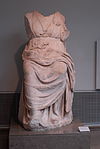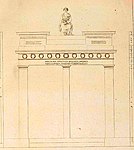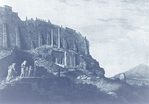Choragic Monument of Thrasyllos
37°58′16″N 23°43′39″E / 37.97111°N 23.72750°E

The Choragic Monument of Thrasyllos is a memorial building erected in 320–319 BCE on the artificial scarp of the south face of the Acropolis of Athens to commemorate the choregos of Thrasyllos.[1] It is built in the form of a small temple and fills the opening of a large, natural cave. It was modified in 271–270 BCE by Thrasykles the son of Thrasyllos, agonothetes in the Great Dionysia Games. Pausanias refers to the monument indirectly,[2] providing us with the information that in the cave there existed a representation of Apollo and Artemis slaughtering the children of Niobe.
Echoing the west part of the south wing of the Propylaea, the facade of the monument is formed by two monumental doorways with antae and a central pillar, door frames, architrave with continuous guttae, frieze and cornice. The frieze was decorated with ten olive wreaths, five on each side of a central wreath, while the cornice supported bases for the choragic tripods. It was built in a variety of marbles from local quarries. On the epistyle there was the inscription:
Thrasyllos, son of Thrasyllos of Dekeleia, set this up, being choregos and winning in the men's chorus for the tribe of Hippothontis. Euios of Chalkis played the flute. Neaichmos was archon. Karidamos son of Sotios directed.
— IG II3 4, 468
Two subsequent inscriptions were added in the years 270–271 BCE, which read:
The demos was choregos. Pytharatos was archon. Thrasykles, son of Thrasyllos of Dekeleia, was agonothete.[3] Hippothontis won the boys’ chorus. Theon the Theban played the flute. Pronomos the Theban directed.
The demos was choregos. Pytharatos was archon. Thrasykles, son of Thrasyllos of Dekeleia, was agonothete. Pandionis won the men's chorus. Nikokles of Ambracia played the flute. Lysippos the Arcadian directed
— IG II3 4, 531
The structure would have been surmounted with three bronze tripods, prizes in the choregia. Stuart and Revett record[4] a statue of Dionysos in place of the original tripods; this was likely a later addition at the time of the repair of the Theatre of Dionysos by Phaidros in the fourth century CE.[5]
Sometime in the Christian period a church was installed in the cave dedicated to Panaghia Spiliotissa. Lord Elgin removed the Hellenistic statue of Dionysos[6] in 1802 as a part of the Elgin Marbles; thus the sculpture was spared when the monument was destroyed by an Ottoman bombardment during the siege of Athens in 1827. Although the monument was scheduled to be restored in the nineteenth century by the Athens Archaeological Society, some of the marble was recarved and reused on the Byzantine church of Soteira Lykodimou. Recent restoration work began in 2002 and draws largely on the measured drawing by Stuart and Revett undertaken in the eighteenth century.[7] It was through the work of Stuart and Revett and J. D. Le Roy's Ruines des plus beaux monuments de la Grece (1758) that the Thrasyllos Monument would influence later architecture. Both Karl Friedrich Schinkel and Alexander Thomson adopted the post-and-lintel construction of the monument in their work.[8]
-
Later statue of Dionysos. British Museum.
-
Stuart and Revett reconstruction.
-
Current state of reconstruction work.
-
Etching of monument as it appeared in the 18th century.
Notes
- ^ Travlos, p.562
- ^ Pausanias I.21.3
- ^ The people of Athens were credited as producers of choregia and Thrasykles only as an official likely due to the sumptuary law of Demetrios. See Camp, 2001, pp.162-3.
- ^ Stuart, Revett, Antiquities of Athens,1787, Vol. 2 Chap. IV
- ^ Travlos, p.562
- ^ British Museum, Seated Dionysos, from the Choregic monument of Thrasyllos, Athens c.270 BC., BM 432
- ^ "Ministry of Culture and Sports | Choregic Monument of Thrasyllos".
- ^ G. Stamp and S. McKinstry, 'Greek Thomson', Edinburgh University Press, 1994, p.192.
References
- Boletis, K. I. (2012). Το χορηγικό μνημείο του Θρασύλλου στην νότια κλιτύ της Ακροπόλεως (Thesis). University of Ioannina.
- J. M.Camp, The Archaeology of Athens, Yale University Press, 2001.
- Geominy, W. (1984). Die Florentiner Niobiden (Thesis). University of Bonn.
- Stewart, Andrew (2017). "The Thrasyllos Monument and its Interior". Hesperia: The Journal of the American School of Classical Studies at Athens. 86 (2): 313–319. doi:10.2972/hesperia.86.2.0273. ISSN 0018-098X.
- Townsend, R.F. (1982). Aspects of Athenian Architectural Activity in the Second Half of the Fourth Century BC (Thesis). University of North Carolina at Chapel Hill. pp. 194–198.
- Townsend, R.F. (1985). "A Newly Discovered Capital from the Thrasyllos Monument". American Journal of Archaeology. 89 (4): 676–680. doi:10.2307/504209. JSTOR 504209. S2CID 191389802.
- Travlos, John (1971). Pictorial Dictionary of Ancient Athens.
- Welter, G. (1938). "Das Choregischen Denkmal das Thrasyllos". Archäologischer Anzeiger. 47: 33–6.
- Wilson, Peter (2000). Athenian Institution of Khoregia. Cambridge.
- Zarkadas, Angelos (2012–2013). "Once lost, now found. A relief from Athens depicting a Niobid". Athenische Mitteilungen: Abteilung des Deutschen Archäologischen Instituts. 127/128: 307–316.
External links
- Lambert, Stephen. "IG II3 4 468: Choregic monument of Thrasyllos, 320/19 BC". Attic Inscriptions Online. Retrieved 18 November 2023.
- Lambert, Stephen. "IG II3 4 531: Dedication by the competition-director, Thrasykles son of Thrasyllos of Dekeleia, 271/0 BC". Attic Inscriptions Online. Retrieved 18 November 2023.




